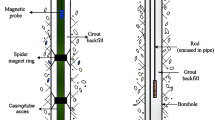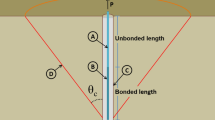The paper presents the method developed to evaluate acting forces in the active anchorage system based on the data provided by multipoint borehole extensometers installed in the chamber-type underground power house cavern of Rogun HPP (Republic of Tajikistan) and the results of its practical application. This method allows for quickly and reliably determination of the actual values of forces in uninstrumented anchors and evaluation of their remaining service life.
Similar content being viewed by others
References
E. G. Gaziev, Stability of Rock Masses and Methods of their Stabilization [in Russian], Stroiizdat, Moscow (1977).
E. G. Gaziev, Rock Mechanics in Construction [in Russian], Stroiizdat, Moscow (1973).
Industry Building Code VSN 506–88. Design and Installation of Ground Anchors [in Russian], Moscow (1989).
Recommended Practices for Testing Temporary Ground Anchors for Excavation Support [in Russian], TsNIIS, Moscow (2001).
EN 1537:1999. Ground anchors. Performance of Special Geotechnical Operations [in Russian].
Author information
Authors and Affiliations
Corresponding author
Additional information
Translated from Gidrotekhnicheskoe Stroitel’stvo, No. 12, December 2019, pp. 38 – 42.
Rights and permissions
About this article
Cite this article
Zyuzin, R.S., Safarzoda, K.A. & Abdulloev, N.M. Monitoring of Forces in the Active Anchorage System Installed in the Underground Structures According to Extensometer Data. Power Technol Eng 54, 58–61 (2020). https://doi.org/10.1007/s10749-020-01167-1
Published:
Issue Date:
DOI: https://doi.org/10.1007/s10749-020-01167-1




